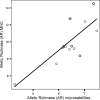Less can be more: loss of MHC functional diversity can reflect adaptation to novel conditions during fish invasions
- PMID: 24223274
- PMCID: PMC3797483
- DOI: 10.1002/ece3.701
Less can be more: loss of MHC functional diversity can reflect adaptation to novel conditions during fish invasions
Abstract
The ability of invasive species to adapt to novel conditions depends on population size and environmental mismatch, but also on genetic variation. Away from their native range, invasive species confronted with novel selective pressures may display different levels of neutral versus functional genetic variation. However, the majority of invasion studies have only examined genetic variation at neutral markers, which may reveal little about how invaders adapt to novel environments. Salmonids are good model systems to examine adaptation to novel pressures because they have been translocated all over the world and represent major threats to freshwater biodiversity in the Southern Hemisphere, where they have become invasive. We examined patterns of genetic differentiation at seven putatively neutral (microsatellites) loci and one immune-related major histocompatibility complex (MHC class II-β) locus among introduced rainbow trout living in captivity (farmed) or under natural conditions (naturalized) in Chilean Patagonia. A significant positive association was found between differentiation at neutral and functional markers, highlighting the role of neutral evolutionary forces in shaping genetic variation at immune-related genes in salmonids. However, functional (MHC) genetic diversity (but not microsatellite diversity) decreased with time spent in the wild since introduction, suggesting that there was selection against alleles associated with captive rearing of donor populations that do not provide an advantage in the wild. Thus, although high genetic diversity may initially enhance fitness in translocated populations, it does not necessarily reflect invasion success, as adaptation to novel conditions may result in rapid loss of functional MHC diversity.
Keywords: Aquaculture escapes; Oncorhynchus mykiss; biological invasions; rainbow trout; rapid evolution; selection.
Figures




References
-
- Aguilar A, Garza JC. A comparison of variability and population structure for major histocompatibility complex and microsatellite loci in California coastal steelhead (Oncorhynchus mykiss Walbaum) Mol. Ecol. 2006;15:923–937. - PubMed
-
- Arismendi I, Soto D, Penaluna B, Jara C, Leal C, León-Muñoz J. Aquaculture, non-native salmonid invasions and associated declines of native fishes in Northern Patagonian lakes. Freshw. Biol. 2009;54:1135–1147.
-
- Ashley MV, Willson MF, Pergams ORW, O'Dowd DJ, Gende SM, Brown JS. Evolutionarily enlightened management. Biol. Conserv. 2003;111:115–123.
-
- Basulto S. El largo viaje de los salmones: una crónica olvidada. Propagación y cultivo de especies acuáticas en Chile. Santiago, Chile: Maval Limitada Editores; 2003.
-
- Bell G, Gonzalez A. Evolutionary rescue can prevent extinction following environmental change. Ecol. Lett. 2009;12:942–948. - PubMed
LinkOut - more resources
Full Text Sources
Other Literature Sources
Research Materials

